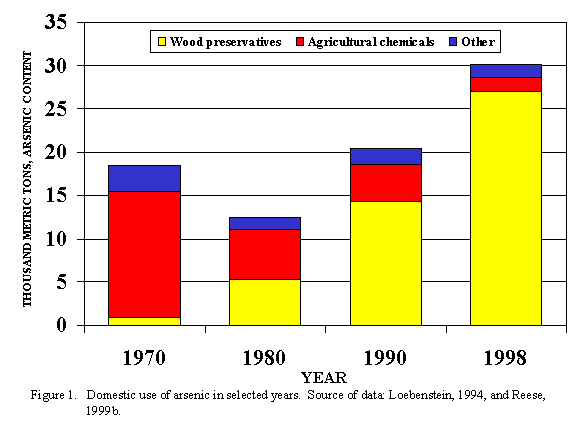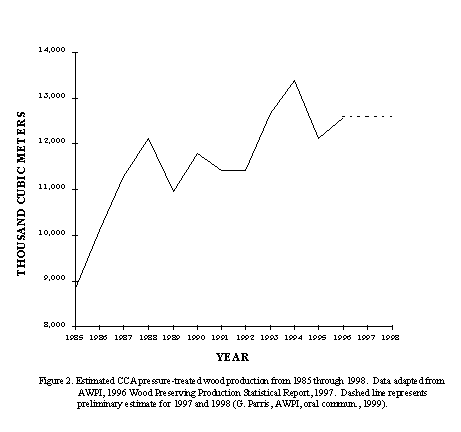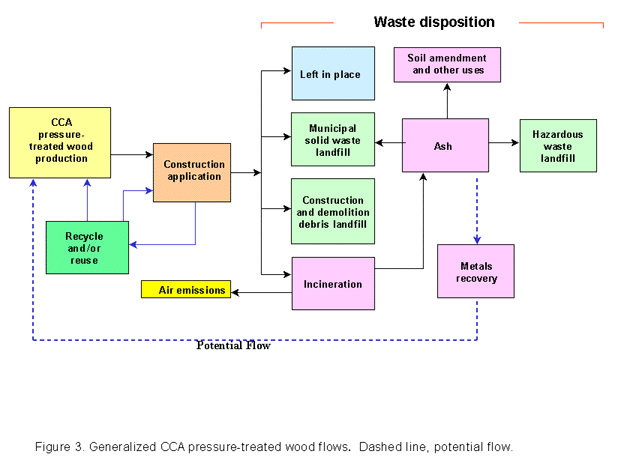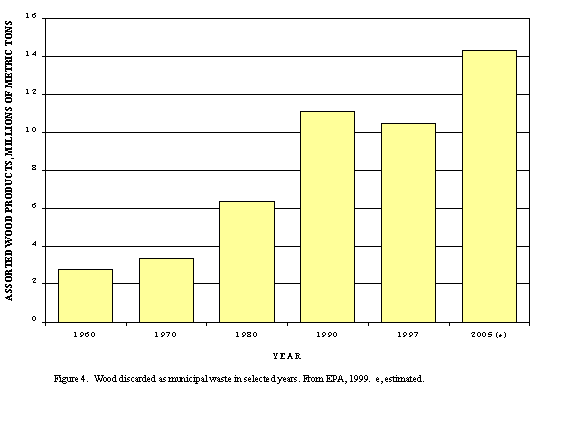

Large amounts of arsenic are becoming widely distributed in the backyards and landfills of the United States as a component of pressure-treated wood. Arsenic is commonly found in relatively low levels in most soils (Healthworld Online, 2000) and in relatively high concentrations associated with copper, lead, and zinc ores and other minerals, especially pyrite (Wolfe, 1983). Nearly all of the world’s supply of arsenic is recovered as a byproduct of smelting concentrates derived from these ores. For most of this century, the United States was among the world's leading producers, but production ended because of the high cost required to reduce atmospheric emissions (which included arsenic) in order to meet environmental regulations (Loebenstein, 1994). Nonetheless, the United States is the largest consumer of arsenic in the world and is now 100 percent dependent on imports to meet all of its industrial needs (Reese, 1999a). Over the last 100 years, arsenic has had several major industrial uses as an essential component of animal feed (to promote growth), herbicides and pesticides, lead batteries, metal alloys, semiconductors, wood preservatives, as well as glass manufacturing (Loebenstein, 1994). In 1998, 30,300 t (metric tons) of arsenic, contained mostly in compound form, was imported into the United States, mainly from the People’s Republic of China (Reese, 1999a). Because of arsenic’s known adverse affects on human health, public concerns have stimulated debate over the safety of the large amounts of arsenic contained in some products, as well as their disposal. This report is a brief characterization of the historic and current flows of arsenic through the economy, with a focus on pressure-treated wood.
Because of its proven health threat to humans and the environment, issues surrounding the metal’s extraction, recovery and processing, use, and disposal have been of widespread interest over the last several decades. For example, the Agency for Toxic Substances and Disease Registry (ATSDR) and the United States Environmental Protection Agency (EPA) listed arsenic as first of 275 substances, in order of priority, that are most commonly found at facilities on the National Priorities List (NPL) (Superfund sites) and which are determined to pose the most significant potential threat to human health due to their known or suspected toxicity and the potential for human exposure. Arsenic, when absorbed through ingestion or inhalation, can exhibit a broad range of symptoms including chronic health effects, including organ damage, cancer, and death (ATSDR, 1989). The EPA has restricted or canceled many of the uses of arsenic in pesticides and is considering further restrictions (ATSDR, 1989). In 1978, the U.S. Occupational Safety and Health Administration concluded that inorganic arsenic is a carcinogen and that worker exposure must be limited (Loebenstein, 1994). In 1980, the EPA listed inorganic arsenic as a hazardous air pollutant based on its findings that inorganic arsenic is carcinogenic (Loebenstein, 1994). Human tolerance to arsenic varies greatly by individual, form of arsenic and its compounds, type of exposure, (usually inhalation or ingestion), and amount and period of exposure (ATSDR, 1989). A range of about 0.05 - 0.30 g is considered a lethal dose if ingested daily over a period less than or equal to 14 consecutive days (ATSDR, 1997). A single ingested dose as small as 130 mg (0.13 g) can be lethal to an adult human being (as reported by Stokinger, 1981).

For the first half of the 20th century, the greatest use of arsenic was in pesticides, owing to the ability of arsenic and arsenic compounds to kill insects, primarily termites and to a lesser extent grasshoppers, and its effectiveness as a fungicide (Loebenstein, 1994). However, in the late-1940 the emergence of new types of organic pesticides on the market had immediate and substantial negative effects on the amounts of arsenic used in the United States (Loebenstein, 1994). In following years, the amount of arsenic used in agriculture continued to decrease dramatically. Federal legislative controls and voluntary substitution by companies occurred in response to the recognition of the potential toxicity of arsenic in the environment. By the mid-1970’s total arsenic use was at its lowest point since 1910, when the use of arsenic as an ingredient in pressure-treated wood began to increase dramatically (fig. 1) (Loebenstein, 1994). The USGS estimated that approximately 1,600 t of arsenic was used for wood preservatives in the United States in 1960, about 10 percent of total domestic use (Loebenstein, 1994). In 1998, arsenic use increased to 27,000 t, of which over 90 percent was supplied for the production of wood preservatives (Reese, 1999b).
Inorganic arsenic, a key component in chromated copper arsenate (CCA), is used to produce pressure-treated wood. CCA is a pesticide regulated by the EPA, and as such the chemical’s handling, use, and disposal must follow the strict government guidelines required for a hazardous material. Pressure-treated wood is produced through a process of exposing wood to CCA in a closed pressurized vessel. The liquid preservative is forced into the cellular structure of the wood in this process. Pressure-treated wood is used for commercial, industrial, and residential applications including decking, highway noise barriers, landscaping, playground equipment, retaining walls, signposts, and utility poles. The greatest benefit of using CCA pressure-treated wood is its resistance to rot and insect attack. Generally, the greater the contact with ground and likelihood of insect attack and rot, the higher the CCA content in pressure-treated wood. Pressure-treating can increase the wood’s serviceable life substantially, from perhaps 3-7 years for untreated wood, to as long as 60 years. Using CCA pressure-treated wood reduces consumption of wood resources and reduces costs because of lower maintenance and less frequent replacement. The actual serviceability of a specific project using pressure-treated wood is dependent on factors including climate, site-specific conditions, type of use, and eventual removal owing to decomposition and or replacement. In Hawaii, more than 45,000 homes were built almost entirely with CCA pressure-treated wood in the mid-1970s (Arcate, 1998) and the State of Louisiana is considering supporting the use of the material as a way to protect homes from termites (G. Parris, American Wood Preservers Institute, oral commun., 1999). The EPA, for the purpose of regulation, has defined CCA pressure-treated wood as a nonhazardous material. The material has a special exclusion from the EPA because the material ends up in disposal sites in the form of the material’s intended use, wood products, and not in the crushed and ground form that is tested in determining whether a product should be classified as a hazardous waste (AWPI, 1997, AWPI Online, 1999).

The production of CCA pressure-treated wood has grown rapidly since the early 1980. Figure two shows that the amount of CCA pressure-treated wood increased from 9 million m3 in 1985 to about 12.5 million m3 in 1996 (AWPI, 1997). Production remained essentially flat through 1998 (G. Parris, American Wood Preservers Institute, oral commun. 1999). Nearly 65 percent was used in lumber, 20 percent in landscape timber and other types of timber, and the balance in other products, including fence posts, poles, and plywood. About 32.6 g (1.15 oz) of arsenic is used in 0.03 m3(1 ft3) of CCA pressure-treated wood (S. Conklin, oral commun., 1999). A residential deck measuring about 3.5 m (12 ft) on a side may contain over 750 g (1.65 lb) of inorganic arsenic. Ash generated from burned CCA pressure-treated wood has much higher concentrations of arsenic.
Government agencies, universities, industries, and organizations have performed studies on the use and disposal of CCA pressure-treated wood products using arsenic and their effects on human health and the environment. A Consumer Information Sheet, approved by the EPA to accompanying each purchase and distributed by the American Wood Preservers Institute, provides guidelines on the proper use, handling, and disposal of pressure-treated wood (AWPI Online, 1999). The guidelines recommend taking some precautions, including wearing a dust mask when cutting, not using pressure-treated wood for cutting boards or countertops, and avoiding contact of pressure-treated wood with public drinking water. Further, the guidelines strongly caution that pressure-treated wood should only be burned under special approved circumstances. Burning pressure-treated wood under any non-approved conditions is illegal in all 50 States (Martin, 1999). The guidelines also suggest that CCA pressure-treated waste should be disposed "by ordinary trash collection or burial" (AWPI, 1998, AWPI Online, 1999).
One of the most significant issues concerning the use of CCA pressure-treated wood is determining if there are environmental risks from the release of arsenic during use and following disposal of the product. Given its widespread use in structures as diverse as playgrounds and pilings, decking and gardens, concerns over the safety of its use and disposal are considerable. Based on mineral statistics published by the U.S. Geological Survey ((Edelstein, 1995, Loebenstein, 1994, and Reese, 1999b), the estimated total amount of arsenic used in pressure-treated wood since 1975 exceeds 300,000 t. Given the sheer quantity of arsenic embodied in CCA pressure-treated products, the cumulative effects of its use and disposal also constitute an important issue. Considering the longevity of the material, most is still in service. If an average useful life of 20 years for CCA pressure-treated wood is assumed (Loebenstein, 1994), then approximately 5,400 t of arsenic contained in CCA pressure-treated wood will be discarded in the year 2000 (fig. 1). Using the same assumption, the amount of arsenic contained in discarded CCA pressure-treated wood could nearly triple to 14,400 t in 2010. When CCA pressure-treated wood becomes waste, as trimmings during construction or when it has reached the end of its useful life, the wood is usually left on site, placed in a construction and demolition landfill, recycled or reused, placed in a municipal solid waste landfill, or incinerated (fig. 3). When left on site, the wood eventually decomposes and the remaining residue is contained in or on the soil. Determination of whether the residues pose environmental and health risks has not been resolved. Potential risks depend on numerous factors including the chemical and physical properties of the soil, precipitation, and physical interaction between arsenic and the biosphere, which includes people, animals, and plants. Total decomposition of the wood could take more than 70 years. Wood, pressure- treated with CCA, can be disposed in municipal solid waste (MSW) and construction and demolition (C and D) landfills. When disposed of, CCA pressure-treated wood is not considered a hazardous waste, although a portion of this material fails EPA’s test for Toxicity Characteristics.

In 1997, over 10 million t of wood waste was discarded in MSW landfills (EPA, 1999). The waste consisted of wood from furniture, pallets, wood scrap, and other items. (The amount of wood ending up in landfills is in itself an environmental issue of volume and available space.) Figure 4 shows that over the years this flow has increased considerably, alongside the increased use of CCA pressure-treated wood. Although not estimated separately, the latter’s flow to landfills has also likely increased. An investigative commission representing the European Union (Austria, Belgium, Denmark, Finland, France, Germany, Greece, Ireland, Italy, Luxembourg, Netherlands, Portugal, Spain, Sweden, and the United Kingdom of Great Britain and Northern Ireland) has several concerns relating to the use and disposition of CCA pressure-treated wood. The Commission agreed that an assessment of long-term behavior of CCA pressure-treated wood in landfills should be an area of study (Hickson Corporation, 1999).

Only since 1993 have new MSW landfills in the United States (or extensions to those existing prior to 1993) been required to install impermeable linings that would contain leachate from wastes for many years. Prior to 1993, MSW landfill linings were not required, and therefore these sites are at greater risk for allowing leakage into the environment. Monitoring wells surrounding active MSW landfills are required in order to determine the amount and extent of any leakage from the facilities. Very few inactive landfills, those closed prior to 1993, are monitored. In addition, landfills that are specifically intended to accommodate only C and D waste are not Federally mandated to require liners, although some States or municipalities do require them. Monitoring of groundwater quality for most C and D landfills is not required. Concerns by members of the public and private sector surrounding arsenic, and for that matter other materials that end up in landfills as consumer waste, involves the question of long-term stability of material and its mobility under conditions which may exist in landfills, especially in those facilities that do not have liners (Arcate, 1998; EBN, 1997).
Another area of environmental concern is the amount of CCA pressure-treated wood sent to incinerators as a supplement for energy generation. Although CCA pressure-treated wood makes up a relatively small percentage of the total wood burned in these facilities, the amount is increasing. These incinerators contain EPA-certified air pollution control equipment that is highly effective at recovering environmental contaminants. However, as the total amount of CCA pressure-treated wood increases so does the amount of arsenic that is released to the atmosphere, as well as the amount of arsenic and other potentially toxic materials contained in the ash. The ultimate disposition of the ash could itself become a problem if sufficiently contaminated by arsenic or other toxic material (EBN, 1999). When (or if) the arsenic content of the ash does exceed the regulatory standards it may have to be treated as a hazardous waste and disposed in designated hazardous waste landfills, at high costs.
Wood ash is commonly used as a soil amendment in parts of the United States where soil is too acidic. Wood ash can improve the quality of soil because it is a source of potassium, lime, and other essential elements and it contains 13 essential nutrients that soil needs for good plant growth (OSUES, 1996). The arsenic content of ash derived from burning CCA pressure-treated wood with other material, however, may exceed allowable limits for use as a soil amendment and may require special handling and disposal as a hazardous waste. Ash that does not exceed allowable limits for arsenic can be used as a soil amendment, but could still contain sufficient arsenic such that continued use could significantly elevate the arsenic content of soils to levels that cause environmental concerns. Some research is being performed at recovering materials from the ash produced by incineration (Scott Conklin, Universal Wood Products, oral commun., 1999). If this procedure becomes economically viable, it holds promise for recycling certain components of the ash, thereby conserving resources. It would also permit the use of ash in useful applications, and if the ash were disposed, it would not need to be treated as a hazardous waste. In the meantime, a simple remedy to this problem is limiting the amount of CCA pressure-treated wood used as a fuel source and rerouting it for recycling.
Not all CCA pressure-treated wood is disposed of in accordance with recommended guidelines. Natural or human-induced catastrophes as well as human ignorance can liberate arsenic and other potentially harmful materials from the disposed product. In the case of a natural disaster such as an earthquake or hurricane, large amounts of pressure-treated wood may be accidentally or by intent burned along with other debris. The potential health and environmental effects from smoke and disposal of ash may not be sufficiently considered. The wood may also be transported to an unlined C and D landfill. On a smaller scale, the same dangers may be present from ordinary structure fires. Whereas firefighters wear sufficient protection, including self-contained breathing apparatus, bystanders could be at risk. Health risks must also be considered during clean up and disposition of ash.
CCA pressure-treated wood is a very useful product that has found application throughout the United States; however, controversy surrounding its use and disposal continues (Arcate, 1998, EBN). Is it safe for all its uses? Are current recommendations for disposal adequate and do they show foresight? What interactions take place between arsenic and the environment? Does the large quantity of the product in use increase overall risk? What are the risks from uncontrolled disposal and burning in structures and in communities following disasters? A new assessment might well be required to resolve these issues.
Arcata, Jim, 1998, Disposing of pressure treated lumber. Accessed October 19, 1999 at URL http://www.biketrack.com/pt-lbr.html
Agency for Toxic Substances and Disease Registry (ATSDR), 1989, Public Health Statement, Arsenic. Accessed October 21, 1999 at URL http://www.atsdr.cdc.gov/ToxProfiles/phs8802.html
---, 1997, CERCLA Priority List of Hazardous Substances. Accessed November 2, 1999 at URL http://www.atsdr.cdc.gov/97list.html
American Wood Preservers Institute (AWPI), 1997, The 1996 wood preserving industry production statistical report: Available from American Wood Preservers Institute, 2750 Prosperity Avenue, Suite 550, Fairfax, VA 22031-4312, 12 p.
---, 1998, Answers to often-asked questions about treated wood, Second Edition: Available from American Wood Preservers Institute, 2750 Prosperity Avenue, Suite 550, Fairfax, VA 22031-4312, 43 p
American Wood Preservers Institute Online (AWPI), AWPI Online, Pressure-treated wood lifecycle management. Accessed September 10, 1999 at URL http://www.awpi.org/lifecycle.html
EBN (Environmental Building News), 1997, Disposal - The Achille's heel of CCA-treated wood. Accessed September 3, 1999 at URL http://www.ebuild.com/Archives/Features/Treated_Wood/Treated_wood_disposal.html
Edelstein, Daniel, 1995, Arsenic: U.S. Geological Survey Minerals Yearbook 1995, p. 71-74.
Environmental Protection Agency (EPA), 1999, Characterization of municipal solid wastes in the United States, 1998 Edition. Accessed October 21, 1999 at URL http://www.epa.gov/epaoswer/non-hw/muncpl/msw98.html
Healthworld Online, 1997, Minerals – Arsenic. Accessed January 27, 2000 at URL http://www.healthy.net/hwlibrarybooks/haas/minerals/as.html
Hickson Corporation, 1999, What is the status of wood preservatives around the world? Available from Hickson Corporation, 1955 Lake Park Drive, Smyrna, GA 30080, 3 p.
Loebenstein, R.J., 1994, The materials flow of arsenic in the United States: U.S. Bureau of Mines Information Circular 9382, 12 p.
Martin, Richard, 1999, Arsenic and CCA pressure-treated wood. Accessed October 20,1999 at URL http://www.origen.net/arsenic.html
OSUES (Oregon State University Extension Service), 1996, Wood ash—Can be useful in yard if used with caution. Accessed September 12, 1999 at URL http://wwwagcomm.ads.orst.edu/agcomwebfile/garden/composting/woodash.html
Reese, R.G. Jr., 1999a, Arsenic: U.S. Geological Survey Mineral Commodity Summaries 1999, p. 26-27.
--- 1999b, Arsenic: U.S. Geological Survey 1998 Annual Review; Minerals Industry Survey, June, 4 p. [Prepared for publication in 1998, U.S. Geological Survey Minerals Yearbook.]
Stokinger, Herbert, 1981, Arsenic in Clayton, F., and Clayton, G., eds., Patty’s industrial hygiene and toxicology: New York, John Wiley, p. 1521-1530.
Wolfe, J.R., 1983,: The hydrometallurgical recovery of arsenic from flue dusts. Arsenic in Ledereer, W. and Fensterheim, R. eds., Industrial, biomedical, environmental perspectives. Van Norstrand Environmental Engineering Series. Van Norstrand Reinhold Company, New York, 442 p.
For more information, please contact: